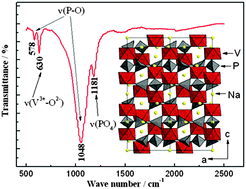A promising Na3V2(PO4)3 cathode for use in the construction of high energy batteries
Abstract
High-energy batteries need significant cathodes which can simultaneously provide large specific capacities and high discharge plateaus. NASICON-structured Na3V2(PO4)3 (NVP) has been utilised as a promising cathode to meet this requirement and be used in the construction of high energy batteries. For a hybrid-ion battery by employing metallic lithium as an anode, NVP exhibits an initial specific capacity of 170 mA h g−1 in the voltage range of 1.6–4.8 V with a long discharge plateau around 3.7 V. Three Na(2) sites for NVP are found capable to be utilised through the application of a wide voltage window but only two of them are able to undergo ions exchange to produce a NaLi2V2(PO4)3 phase. However, a hybrid-ion migration mechanism is suggested to exist to describe the whole ion transport in which the effects of a Na-ion “barrier” results in a lowered ion diffusion rate and observed specific capacity.


 Please wait while we load your content...
Please wait while we load your content...